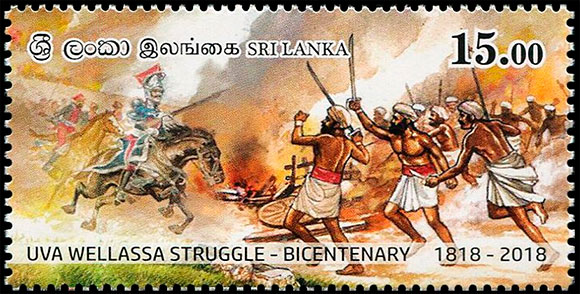
On November 30, 2018, Sri Lanka Post issued a stamp commemorating the 200th anniversary of the Uva-Vellassa Rebellion.
By 1802, the British had finally subjugated the former Dutch colonies in Ceylon and established dominion over the island's coastal regions. They then focused their military and political efforts on conquering the Kandyan Kingdom, the last independent Sinhalese state in Ceylon. Through complex intrigues and bribery, the British succeeded in winning the support of some Kandyan nobles who were dissatisfied with the actions of their ruler, Sri Vikram Rajasingha, who, in an attempt to strengthen the Kandyan armed forces to defend against the British, limited the privileges of the local elite, imposed new taxes, and encroached on the property of the Buddhist clergy. This alienated many of his former adherents and led them into an open alliance with the British. In 1815, the Kandyan state was occupied by British troops.
In early March 1815, a convention was signed in Kandy between the British colonial authorities and representatives of the Kandyan aristocracy. Under its terms, full power was transferred to the British military command. The former ruler of the Kandyan state was officially deposed, and its territory was incorporated into the British colonial possessions. All rights and privileges previously enjoyed by local feudal lords, as well as their local authority, which had been revoked by the last Kandyan monarch, were restored. The leaders of the Buddhist sangha also received the necessary assurances of support.
In an attempt to improve the effectiveness of their governance in the new territories, the British gradually began to strip privileges from local feudal lords and Buddhist monasteries. For this reason, in 1817, local princes, with the support of the Buddhist sangha, rallied the masses in an attempt to overthrow the rule of the British colonialists.
The Uva-Wellassa Rebellion took its name from two former provinces of the Kingdom of Kandy. Gradually, the rebellion spread to many central provinces. However, due to disunity among the local feudal lords, they were unable to coordinate their actions and present a united front against the British. The British, having reinforced their colonial troops with additional sepoy detachments, were able to suppress the resistance of the disparate rebel groups in 1818.

After the suppression of the rebellion, all its participants were condemned as "traitors." Some were executed, others were exiled to Mauritius, and all their property was confiscated by the British government. During the military operations, a huge number of civilians were killed, hundreds of villages were destroyed, the entire infrastructure of the Uva and Wellassa provinces was destroyed, rice fields were burned, trees were cut down, and irrigation systems were disrupted. After Sri Lanka gained independence in 1972, the leaders and participants of the uprising were recognized as national heroes. Two hundred years later, locals consider the Uva-Wellassa Rebellion one of the bloodiest chapters in the history of colonial rule. Several memorials to the heroes of those historical events have been erected throughout the province.
Перейти в каталог
I apologize for any errors or inaccuracies


